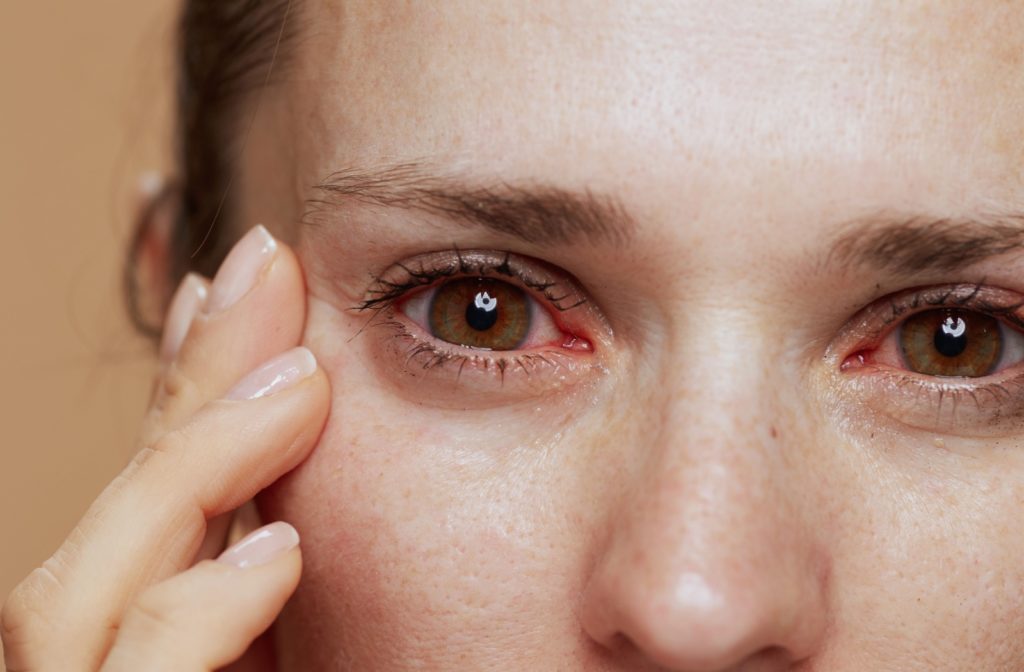A hallmark sign of eye irritation is the eye’s surface turning pink. Some individuals may use “pink eye” as an umbrella term for any eye condition that causes this discolouration to develop. However, pink eye and pink discolouration are different from one another. In technical terms, pink eye is not an umbrella term for eye irritation or conjunctivitis.
The typical “pink eye” term we hear used occurs when the conjunctiva becomes inflamed from a bacterial infection, which is contagious. Eye conditions like blepharitis, dry eyes, and keratitis, as well as foreign bodies and styes, can also cause the eye surface to turn red or pink, which is conjunctivitis. However, unless it’s a bacterial infection, it is not the “pink eye” we all think of.
The accompanying symptoms of pink eye and other eye conditions help optometrists determine an accurate diagnosis for eye irritation, which is key for effective treatment and providing long-term relief.
Understanding Pink Eye
Pink eye is medically known as bacterial conjunctivitis, characterized by the eye’s surface turning pink from a bacterial infection, hence the term “pink eye”.
Conjunctivitis refers to the inflammation of the conjunctiva, the thin layer covering the white part of your eye and inside your eyelids. The inflammation causes the blood vessels in your eye to become more visible, resulting in pink or red discolouration.
Pink eye is common and can occur regardless of age. Due to the highly contagious nature of bacterial conjunctivitis, we see this most commonly among children as they often come into close contact with others, have a habit of rubbing their eyes, and forgo thoroughly washing their hands. Regardless of age, all of these factors increase the risk of spreading pink eye.
There are several types of conjunctivitis:
- Infectious Conjunctivitis: Viral conjunctivitis, often caused by the common cold virus and upper respiratory tract infections, can be infectious and results in a glossy red eye with tearing and light mucus. Bacterial conjunctivitis, more common in children than adults, is also infectious, often characterized by significant yellow pus discharge as well as heavy crusting of the eyelashes.
- Chemical Conjunctivitis: Chemicals, fumes, and smoke can cause pink eye. This form of conjunctivitis is not contagious.
- Allergic: Irritants like pollen, grass, smoke, dust, or dander can trigger an allergic reaction and cause allergic conjunctivitis. Allergic conjunctivitis is also not contagious.
- Foreign bodies: Having a foreign body in the eye can cause conjunctivitis, as it can scratch the conjunctiva, resulting in inflammation, swelling and redness.
Common symptoms of conjunctivitis include:
- Pink or red discolouration of the eye
- Itching, irritation, or burning of the eye
- Sticky discharge, mucus or pus
- Watery eyes
- Swollen eyelids
Importance of an Accurate Diagnosis
An accurate diagnosis of the type of conjunctivitis is key to effective treatment. Each type of conjunctivitis requires its own approach to care. Misdiagnosing your pink eye can lead to further discomfort and prolong healing.
Bacterial conjunctivitis is often treated with antibiotic eye drops, while viral conjunctivitis usually resolves on its own, or assisted with artificial tears. Allergic conjunctivitis usually improves by removing the allergen from an individual’s environment, and with prescription antihistamine eye drops.
While a pink eye, or conjunctivitis, is generally not serious, untreated cases can lead to more complications like corneal inflammation and vision concerns. Visiting your optometrist when eye irritation develops is vital to avoid these complications.
Eye Conditions That Look Like Pink Eye
A misdiagnosis of pink eye is common as many eye conditions share similar symptoms to conjunctivitis. An accurate diagnosis from your eye doctor can help prescribe effective treatment and achieve long-term relief.
The main reason other eye conditions can be mistaken for pink eye is the simple pink discolouration of the eye’s surface. This is not unique to the typical bacterial “pink eye,” as it’s a symptom of several eye conditions. Ocular health assessments, proper tools, and recognizing other symptoms help differentiate other eye conditions from pink eye.

Blepharitis
Blepharitis is an eye condition that refers to inflammation of the eyelids, often caused by bacteria or skin conditions like dandruff or rosacea. Blepharitis primarily affects the eyelids and eyelashes rather than the eye itself.
The redness, eye crusts, itching, and swelling associated with blepharitis can be mistaken for bacterial pink eye. However, blepharitis differs from conjunctivitis as this condition is generally focused on the eyelids and is accompanied by flaking of skin around the eyelashes. This condition is not contagious and can be managed and treated by practicing good eyelid hygiene.
Dry Eye
Dry eye is characterized by a dry, gritty sensation in the eye, feeling almost as if there’s something in the eye. It occurs when the eye doesn’t produce enough tears or when tears evaporate too quickly because of an unstable tear film.
This dryness results in symptoms that overlap with conjunctivitis, such as redness, burning, and excessive watering as your eyes are compensating for a lack of moisture.
Dry eyes are a common condition where the dryness gradually develops while infectious conjunctivitis can appear suddenly. Unlike bacterial and viral conjunctivitis, dry eyes aren’t contagious and can be effectively managed with home remedies and advanced therapies.
Keratitis
Keratitis is a condition that causes the cornea to become inflamed, often due to eye infection, a corneal ulcer, injury, or improper contact lens care.
Like pink eye, keratitis can cause redness, pain, and tearing in the eyes, sensitivity to light, and blurred vision.
However, a corneal ulcer usually only affects one eye. Keratitis is painful, and it may feel as if there’s something lodged in the eye. If left untreated, keratitis can lead to vision loss.
Styes
A stye is a red, swollen lump near the edge of the eyelid, resembling a pimple. It’s commonly caused by a bacterial infection of an eyelash follicle.
Both conditions share similar symptoms. They can cause significant redness and swelling around the eyes, excessive tearing, and irritation.
Unlike conjunctivitis, a stye affects the eyelid rather than the eye itself. It’s localized and painful, often accompanied by a small, pus-filled bump on the eyelid.
Schedule an Appointment
Understanding the difference between pink eye and other eye conditions that can cause redness is key to effective treatment. Visiting your optometrist when irritating symptoms develop promotes healing and helps provide long-term relief.
Connect with our team at Discover Eyecare to schedule a visit for a health assessment to help manage eye conditions and provide long-term relief.



